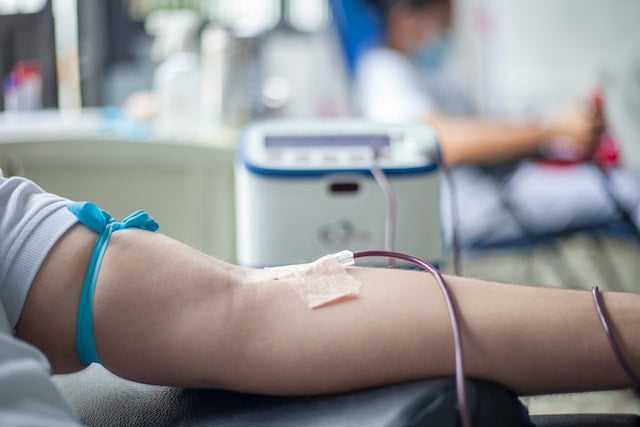During intravenous drug administration, the IV site is exposed to getting infected, getting hurt, or dislocating due to movement. These problems sometimes increase the risk of damage associated with the injury at the IV site, something which is preventable if the site is covered with the aim of its protection. For this purpose, dressings have been designed which restrict the transfer of microbes to the IV site while allowing the gases and vapors to escape from the area. Among these transparent dressings, 3M tegaderm patches are notable due to their superior quality. Let us understand what a tegaderm patch is and how it is used.
What is a tegaderm patch?
Tegaderm patches are single-use, transparent films that are sterile in nature and intended to be used at the sites of injury. These patches are efficient in covering the wounds thus providing enhanced protection. Tegaderm patches have vast applications in clinical setups due to their ease of application and efficient performance.

Intravenous drug administration
Characteristic features of 3M tegaderm patches
Tegaderm patches have the following notable characteristics:
- Tegaderm patches are sterile and single-use which eliminates any risk of being infected through their application.
- These are breathable as well as completely
- The tegaderm patches are completely impervious to microbes.
- The patches are transparent which enables the healthcare provider to examine the site of injury without removing the film.
- The adhesive used to stick these patches in place is hypoallergenic and latex-free.
- Tegaderm patches are available in different sizes and shapes to choose from based on the needs of the patient.
- Tegaderm patches are radiologically transparent which eliminates the need for their removal during an X-ray.
Application of a tegaderm patch
A tegaderm patch is a valuable tool for wound care and catheter security. Proper application is crucial for its effectiveness. Let us explore the key steps for precise tegaderm patch application:
- Select a suitable size of tegaderm patch based on the site of injury. Make sure that the patch has at least a one-inch margin needed for skin adherence.
- Following the hospital’s approved protocols, the injured or catheter site must be made ready. It is essential for the site to be completely dry for the application of tegaderm patch.
- If the site is hairy, the excessive hair must be clipped rather than shaving them to avoid the possibility of abrasions.
- Peel the tegaderm patch with care and apply it on the skin with firm pressure to ensure proper placement.
- Make sure not to stretch the patch while applying as it can generate tension at the site of injury which can cause damage to the skin.
Removal of a tegaderm patch
After a tegaderm patch has served its purpose, proper removal is vital to prevent any discomfort or accidental dislodgement of IV tubing or catheters. Let us learn how to remove a tegaderm patch safely.
- Similarly, for the removal of tegaderm patch, it is essential to stabilize the IV tubing or catheter with one hand to prevent accidental dislodgement.
- With gentle care, peel the tegaderm patch from one end and roll it back on itself.
Indications for tegaderm patches
Tegaderm patches are suitable to be used on IV as well as catheter sites. The wounded sites which get protected by tegaderm patches are as follows:
- Lightly draining wounds
- Sacral wounds
- Wounds occurred due to burning
- Cleaned and stitched sites followed by surgery

Drug administration via IV route
The catheter sites on which the tegaderm patches are used include:
- Epidural catheters
- Umbilical catheters
- Subcutaneous insulin catheters
- Dialysis catheters
- Tunneled catheters
- Implanted ports
- Pulmonary artery catheters
- Peripherally inserted central catheters (PICC)
- Subclavian and jugular catheters
- Peripheral and midline catheters
Benefits of tegaderm patches
The tegaderm films, when in use, provide the following advantages:
- The tegaderm film acts as a barrier against the moisture thus hindering its evaporation from the IV site. This keeps the wounded area moist which helps the recovery process. Moreover, the process of autolytic debridement, i.e. breakdown, and clearing of tissue damaged due to injury by the body’s own enzymes, is also facilitated.
- It can also be applied to wounds such as skin abrasions, blisters, or skin tears. Similarly, skin graft donor sites can also be covered using tegaderm transparent films. Stage I and II pressure ulcers can also be protected by this dressing.
- Tegaderm patches are also employed to act as a secondary dressing over the primary one including gauze, hydrogels, or alginates. It gives the wound extra protection against the environment.

IV set employed in a person’s veins while blood donation
- It can also be used on a skin area that is at risk of getting infected or injured as a protective coating. These also include closed surgical incisions.
- Tegaderm patches also restrict the movement of devices on the skin by securing them in their place.
- Tegaderm patches are also effective in covering burns to prevent them from being affected by the environment.
- These patches also aid in protecting the eyes by acting as a covering.
Demerits of tegaderm patches
Although the tegaderm patches are extensively used in hospital setups, there are some demerits these consumables have which are as follows:
- As the tegaderm patches are single-use, these cannot be resterilized by gamma rays, E-beam, or steam.
- The site where the tegaderm patch is applied may become red and swollen followed by a sensation of burning and tingling.
Conclusion
Among the multiple dressing options employed to secure the IV or catheter sites, tegaderm patches are most frequently used owing to their dominant characteristics, ease of application and removal, as well as their employment in a wide range of indications. Due to being sterile, the risk of acquiring an infection while using tegaderm patches is also significantly minimized. Moreover, they are X-ray friendly and do not require removal while examination of the site in injury. These features have rendered tegaderm patches a product of choice in hospital setups.

PhD Scholar (Pharmaceutics), MPhil (Pharmaceutics), Pharm D, B. Sc.
Uzma Zafar is a dedicated and highly motivated pharmaceutical professional currently pursuing her PhD in Pharmaceutics at the Punjab University College of Pharmacy, University of the Punjab. With a comprehensive academic and research background, Uzma has consistently excelled in her studies, securing first division throughout her educational journey.
Uzma’s passion for the pharmaceutical field is evident from her active engagement during her Doctor of Pharmacy (Pharm.D) program, where she not only mastered industrial techniques and clinical case studies but also delved into marketing strategies and management skills.
















